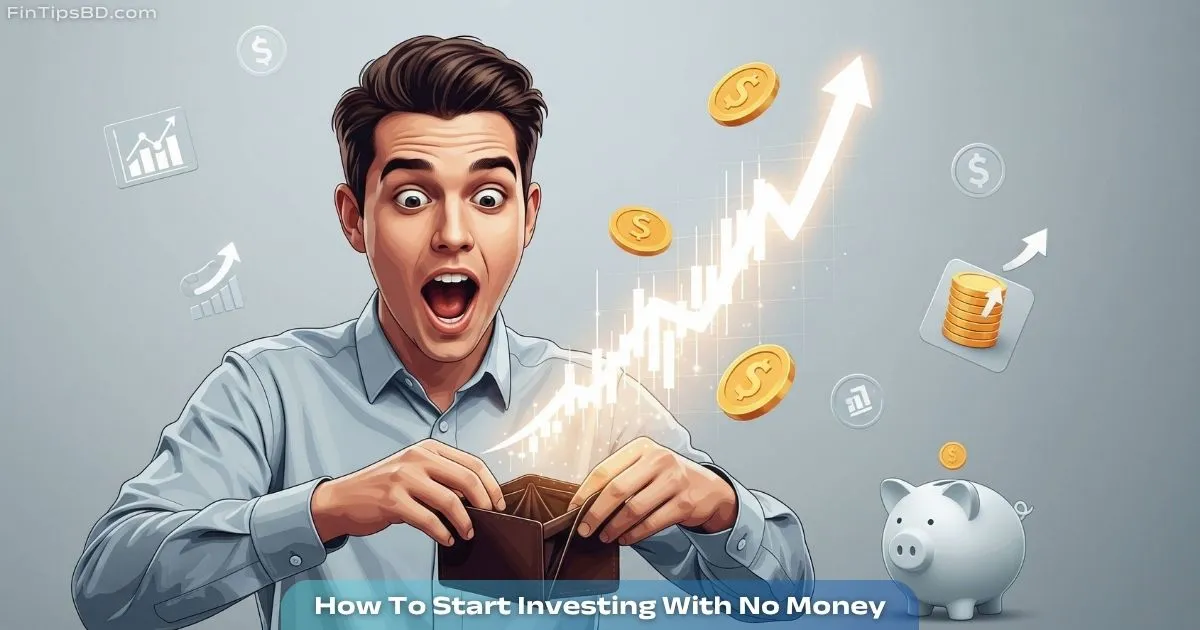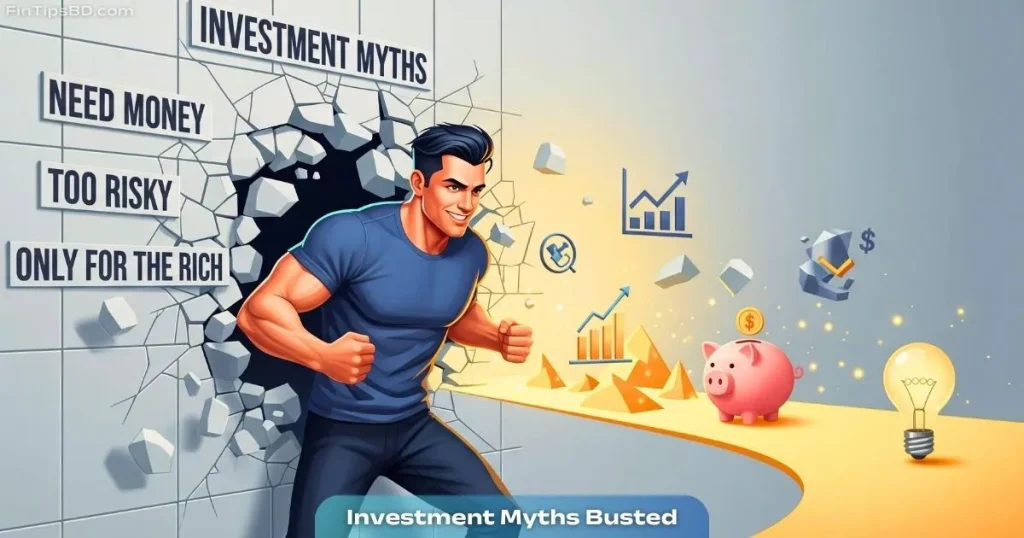How To Start Investing With No Money – The Shocking Truth No One Told You

It’s a common misconception that you need a lot of money to start investing. The truth is, you can start with little to no capital. It’s not about the size of your initial investment, but the strategies you use.
Today, many financial tools and platforms have made investing accessible to everyone. Whether you’re a student on a tight budget, living paycheck to paycheck, or just starting out, this guide will show you How to Start Investing smartly, safely, and successfully, even if your bank account seems empty.
Table Of Contents
Why Investing Early Matters (Even When You’re Broke)
Many people delay investing, waiting for the “right time.” Here’s why you should start your investment journey now, regardless of your financial situation:
- Compound Interest: The earlier you start, the more time your money has to grow thanks to compound interest. Your earnings begin to generate their own earnings, leading to significant growth over time.
- Building Habits: Even small contributions help you develop the discipline needed for long-term wealth building. It’s about creating a consistent habit that will benefit you for decades.
- Fighting Inflation: Your money loses purchasing power over time due to inflation. Investing helps protect your wealth and ensures its value doesn’t decrease.
So, don’t wait until you have thousands. Start where you are, using the knowledge, tools, and strategies available to you right now.
Investing in Knowledge: Your First and Most Important Step

If you don’t have money to invest right now, your most crucial investment should be in knowledge. This intellectual capital will be your foundation, guiding your future financial decisions.
Dedicate your time to:
- Reading Investment Books: Dive into classics like Benjamin Graham’s The Intelligent Investor or Robert Kiyosaki’s Rich Dad Poor Dad. These books offer timeless wisdom and fundamental principles.
- Engaging with Financial Content: Subscribe to reputable finance YouTube channels or podcasts. Listen to experts, stay updated on market trends, and get diverse perspectives.
- Taking Free Online Courses: Platforms like Coursera, edX, and Khan Academy offer many free online investing courses. These structured learning environments can give you a solid understanding of financial markets and investment strategies.
By building a strong financial foundation through education, you’ll gain the confidence and clarity to act when the right opportunities arise. As Warren Buffett famously said, “The best investment you can make is in yourself.”
How to Start Investing with Fractional Shares
One of the easiest ways to start investing with little to no money is through fractional investing. This innovative approach means you don’t have to buy an entire share of a company, which can often be expensive.
For example, if one share of Tesla costs $300, a fractional share platform lets you invest as little as $10, owning just a portion of that share. This opens up access to high-value stocks that were previously out of reach for many.
Consider these popular platforms that offer fractional share investing:
- Robinhood: Known for its easy-to-use interface, Robinhood offers trades with minimums as low as $1 and charges no commission fees.
- Public.com: This platform combines social investing with fractional shares, allowing you to follow and learn from other investors.
- Fidelity or Charles Schwab: These established brokerage firms have embraced fractional investing, providing a trusted environment for beginners.
- Acorns: This app automates investing by rounding up your everyday purchases and investing the spare change.
These tools are designed to help beginners enter the investment world, even with very limited funds.
How to Start Investing with Robo-Advisors
If managing your own investment portfolio seems overwhelming, robo-advisors are an excellent solution. These platforms use algorithms to automatically build and manage a diversified investment portfolio tailored to your financial goals and risk tolerance.
Many robo-advisors accommodate very small initial investments and handle crucial tasks like portfolio rebalancing and dividend reinvestment, making the process much simpler.
Leading robo-advisors include:
- Betterment: A pioneer in the robo-advisor space, Betterment offers goal-based investing and personalized financial advice.
- Wealthfront: Known for its tax-loss harvesting capabilities and robust financial planning tools.
- SoFi Automated Investing: Provides a comprehensive suite of financial products, including automated investing with no advisory fees.
Robo-advisors are perfect for those who want to start investing without being bogged down by complex financial decisions.
Fuel Your Investments with a Side Hustle
While this method involves earning money, it’s a highly effective way to go from “zero-to-investor.” Starting a side hustle generates additional income that you can specifically set aside for investments. This creates a dedicated funding stream for your portfolio.
Consider these ideas for generating extra income:
- Freelancing: Use your skills in writing, graphic design, programming, or virtual assistance on platforms like Upwork or Fiverr.
- Selling Digital Products or Online Courses: If you’re an expert in a specific area, create and sell e-books, templates, or online courses.
- Content Creation: Build an audience on platforms like YouTube, TikTok, or a personal blog, and monetize through advertising, sponsorships, or direct sales.
- Affiliate Marketing or Print-on-Demand: Promote products or services as an affiliate and earn commissions, or design custom merchandise to sell without holding inventory.
Once you start earning, even a small amount, commit a portion of it directly to your investment portfolio. This consistent dedication builds both a powerful habit and a sustainable source of long-term wealth growth.
Transform Daily Spending into Investments
Surprisingly, you can even invest without actively saving by using tools that convert your everyday purchases into investment capital. This passive approach allows your money to work for you in the background.
Here’s how to start investing with your spending:
- Cashback Apps: Use debit or credit cards that offer cashback rewards and automatically direct those earnings into an investment account.
- Round-Up Apps: Like Acorns, these apps round up your purchases to the nearest dollar and invest the spare change. It’s an easy way to gradually build your portfolio.
- Loyalty Programs: Some forward-thinking reward programs now offer stock rewards instead of traditional points, directly funneling value into investments.
This strategy is particularly effective because it works seamlessly in the background, requiring minimal changes to your existing lifestyle.
Leverage Your Employer’s Retirement Plan
If you’re employed, ask about your company’s retirement plan, such as a 401(k) or a similar scheme. Even if your current financial situation limits your contributions, simply enrolling can unlock significant benefits:
- Free Employer Matching: Many companies offer to match a percentage of your contributions (often 3-5%). This is essentially “free money” that immediately boosts your investment.
- Tax Benefits: Contributions to employer-sponsored plans often come with tax advantages, such as pre-tax contributions that reduce your taxable income.
- Automatic Investing: Funds are typically invested automatically into diversified options, reducing the need for active management on your part.
This is often the most straightforward and secure way to begin investing with minimal effort, especially when your employer contributes on your behalf.
Diversify with Crowdfunding and Peer-to-Peer Investing
For those looking to explore alternative investment avenues, options with low minimums are available:
- Real Estate Crowdfunding: Platforms like Fundrise or RealtyMogul allow you to invest in fractional ownership of properties with as little as $10 or $100, making real estate accessible to a wider audience.
- Peer-to-Peer (P2P) Lending: Through platforms such as LendingClub or Prosper, you can lend small amounts to individuals and earn interest on your principal.
- Micro Crypto Investing: Platforms like Coinbase or Binance enable you to purchase tiny portions of cryptocurrencies like Bitcoin or Ethereum. However, it’s crucial to be extremely careful and do thorough research due to the inherent volatility and risk associated with cryptocurrencies.
While these options carry higher risks compared to traditional investments, they offer accessible entry points for beginners with limited funds.
Debunking Investment Myths: Investing Without Money Is a Reality

Let’s tackle some common myths that often stop aspiring investors:
| ❌ Myth | ✅ Truth |
| You need a lot of money to start. | You can begin with as little as $1. |
| Investing is only for the rich. | Investing is for anyone with a smartphone and internet access. |
| It’s too risky for beginners. | With education and the right tools, you can invest safely. |
| You need a financial advisor. | Robo-advisors and learning platforms make it easy to manage. |
Your 3-Step Action Plan to Start Investing Now
You don’t need to accumulate vast wealth to become an investor. Implement this actionable plan today:
- Step 1: Learn. Dedicate at least 30 minutes daily to reading or watching investment-related content. Consistent learning builds foundational knowledge.
- Step 2: Choose a beginner-friendly platform. Select a platform like Robinhood, Fidelity, or Acorns that aligns with your comfort level and investment goals.
- Step 3: Start small. Even investing $1 per week builds incredible momentum and reinforces the habit of consistent investing.
Remember, what truly matters most is the consistency of your efforts, not the initial amount you invest.
Final Thoughts: Begin Where You Are
The fundamental truth is simple and powerful: you don’t need money to start investing—you need commitment. By strategically using fractional shares, leveraging cashback rewards, engaging with robo-advisors, and most importantly, investing in knowledge, you can start building wealth today.
It’s not about perfectly timing the market or waiting for an ideal financial situation. It’s about using what you already have—your time, available tools, and a proactive mindset—to build a more secure and prosperous future. The sooner you embark on this journey, the stronger your financial future will undoubtedly become. Start now.
Keywords: start investing with no money, investing for beginners, fractional investing, how to invest smart, beginner investment tips, invest with little money, zero capital investing, micro investing, invest without money, best investing platforms for beginners
